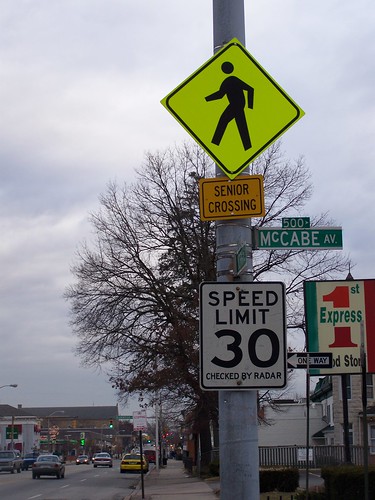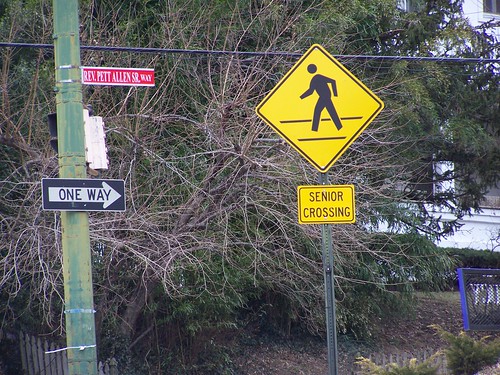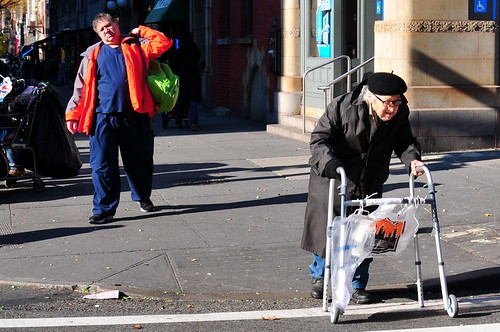Making cities work better for the aged
In the comment thread on this post, "Understanding why Upper Northwest DC residents don't buy into the sustainability mobility paradigm," there was some good discussion about how to provide non-car dependent mobility options as people get older.
Some people in Chevy Chase--younger than I it turns out--said the paradigm I outlined was something appropriate only for the young, whereas I expect to be getting around that way into my 70s (20 more years...).
 Below, I am running the press release from Community AGEnda, an initiative of Grantmakers In Aging (GIA) supported by the Pfizer Foundation, which is focused on providing tools and supporting pilot projects to support aging populations in terms of urban design, mobility, and programs.
Below, I am running the press release from Community AGEnda, an initiative of Grantmakers In Aging (GIA) supported by the Pfizer Foundation, which is focused on providing tools and supporting pilot projects to support aging populations in terms of urban design, mobility, and programs.Here are some comments, which are probably best read after reading the release.
1. One of the problems of all the various village programs is that they duplicate organization, at least in DC. We probably have 10 different programs. All want to have their own directors, etc. I wonder if it would be better to organize these programs across a larger scale, not necessarily a whole city, but larger, so that administration requirements are not unnecessarily duplicated?
2. how come no demonstration programs for transit and aging populations? Interacting with my wife's parents when we travel together, this is an issue... But it's an issue in cities generally, problems with paratransit service economics, etc. (There is a Community AGEnda initiative on mobility in Kansas City, where they have bus transit, but not light rail and/or subways.)
3. one issue people don't talk about with aging in place programs is that they are designed to reduce housing turnover, but at the same time, lack of housing turnover within neighborhoods can lead to economic stagnation in local retail districts, because older households buy less, don't go out to eat, etc. This is especially going to be a problem in suburban counties, but I also think it is one of the reasons that DC neighborhood commercial districts stagnated in the 1980s and 1990s.
 4. In DC, there is a similar program to your Miami initiative, Connecticut Avenue Pedestrian Action. One of the leading groups involved is a senior services organization, Iona. There are lots of apartment buildings, with older residents, some are defined senior housing programs, others aren't.
4. In DC, there is a similar program to your Miami initiative, Connecticut Avenue Pedestrian Action. One of the leading groups involved is a senior services organization, Iona. There are lots of apartment buildings, with older residents, some are defined senior housing programs, others aren't.5. In inner cities, there is the crime issue. Older residents out and about, can be targets, because they move slower, etc.
6. See "" from the Philadelphia Inquirer and "" from the Baltimore Sun.
----------------
From the press release:
... today released a set of important tools and resources to inform and inspire planners, philanthropies, and others seeking to build a more age-friendly future. These materials are available free online.
The tools include Age-friendly America, a searchable online database with contact information and background on more than 200 age-friendly projects; Age-Friendly Communities: The movement to create great places to grow up and grow old in America: An introduction for private and public funders, an overview of the goals and accomplishments in the field to date; and Aging Power Tools: A curated selection of resources to promote stronger, age-friendly communities, a robust collection of tools from top practitioners.
Age-friendly communities: the value proposition
“We think that every community in America could benefit from this forward-looking approach,” said John Feather, PhD, CEO of Grantmakers In Aging. “For foundations and other funders looking for maximum long-term impact, it’s hard to beat age-friendly community development, which is highly collaborative, adaptable to diverse communities, and offers benefits for residents of all ages.”
“The aging of America represents a profound societal change that we’re living through right now,” said Caroline Roan, president of the Pfizer Foundation. “We believe it can present a great opportunity if we work together, take steps to become more age-friendly, and re-imagine how our communities can help us grow old with dignity, in the places we care about.”

What makes a community age-friendly?
Age-friendly initiatives take various forms but all share the goal of creating better options for people to age in place and continue contributing to their communities. This may involve improvements to the built environment, from planning and building safe outdoor spaces to creating affordable, accessible housing; or improving infrastructure, such as more walkable town centers or more accessible public transportation. Other age-friendly initiatives tackle social needs, creating engaging cultural and outdoor activities, services, and volunteering options.
Photo above by Ed Yourdon via Flickr.
With Americans living longer and 10,000 Boomers turning 65 every day, those over age 65 will make up 20 percent of the American population by the year 2030, making age-friendly innovation more needed than ever.
Community AGEnda sites and activities
In its first year, Community AGEnda supported five programs with grants of $150,000, requiring each grantee to raise matching funds of one-third or more of the value of the grant. Their age-friendly activities include:
• In Miami-Dade County, Florida: collaborating with the county parks to serve older adults better, conducting a walkability study in East Little Havana, preparing the area’s employers to hire and retain more older adults, and working with Miami-Dade County to review and modify planning policies related to transportation, housing, land use, and community design;
• In four communities and two counties in the Atlanta metropolitan area: supporting community gardens, establishing a health and wellness promotion plan, conducting a walkability assessment, and hosting workshops about the need to create age-friendly communities;
• In Maricopa County, Arizona: planning and implementing pilot programs using the Village model of membership-driven services and volunteerism to promote aging in community, producing a video on aging in place, and creating a new website to help “younger” older adults (ages 55-70) find the resources to age in place comfortably, safely, and affordably;
• In Bloomington, Indiana: discussing development incentives to create an age- and ability-friendly Lifetime Community District; in Indianapolis, creating a conceptual illustration for the Martindale-Brightwood neighborhood to highlight potential development opportunities; and in Huntington, Indiana, engaging stakeholders to focus on housing, transportation, and accessibility issues; and
• In the greater Kansas City area: working to improve transportation and mobility options for older people in urban and surrounding suburban areas, raising awareness of caregiving issues and the need to tap into the expertise of older adults as community resources, and working with the First Suburbs Coalition to produce a toolkit to assist elected officials and planners in developing the capacity to assess and plan for an increased older adult population.
Labels: aging, demographics, equity, land use planning, transportation planning, urban design/placemaking



0 Comments:
Post a Comment
<< Home